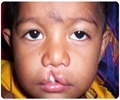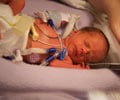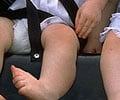The genetic cause for two types of birth defects found in newborn boys has been discovered by Baylor College of Medicine scientists.

Cryptorchidism is characterized by the failure of descent of one or both testes into the scrotum during fetal development. In the adult man, the testes produce sperm and the male hormone, testosterone. Hypospadias is the abnormal placement of the opening of the urethra on the penis. Both birth defects are usually surgically repaired during infancy.
Cryptorchidism occurs in about 3 percent of full term male births. Similarly, the incidence of hypospadias is about 1 in 125 births.
Lamb and colleagues used a method of genome wide screening (essentially a molecular karyotype) called array comparative genomic hybridization to study children with these defects. The method looks specifically at changes in chromosomal regions that have undergone duplication or deletions too small to see under a microscope, termed copy number variations. These genomic changes can alter gene dosage (gene gains or losses) resulting in a change in cell function.
In its analysis, the team showed that the cause of these birth defects in a subset of children with these defects of testis and penile development resulted from a change in the number of copies of a gene, VAMP7.
"The birth defects were a result of microduplication on the X chromosome that altered estrogen receptor and androgen receptor action in ways not previously recognized," said Lamb.
Advertisement
The gene duplication occurred in 1.35 percent of the 324 patients studied, but was not present in nearly 9,000 control subjects who did not have these birth defects.
Advertisement
The association of this gene duplication with the male reproductive tract birth defects was validated with mouse models that mimicked the human genomic duplication.
The Lamb laboratory observed the presence of the same birth defects in the mouse model as occurred in the children proving causation beyond an association.
The role of VAMP7 gene duplication in causing these male birth defects was important because of the type of protein family it belongs to – it is a SNARE (Soluble N-ethylmaleimide-sensitive factor activating protein receptor) protein (a large protein superfamily consisting of more than 60 members in yeast and mammalian cell), Lamb said.
"This SNARE protein traffics the movement of other proteins in the cell. No one had ever considered that a minor change in the amount of this protein could so profoundly impact the estrogen receptor and to a lesser extent androgen receptor action resulting in these male reproductive birth defects."
The findings will help improve diagnosis and, hopefully, ultimately treatment, she said.
Source-Eurekalert















